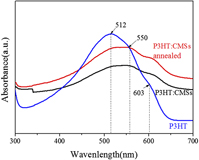Article contents
Synthesis and optical property of P3HT/carbon microsphere composite film
Published online by Cambridge University Press: 19 November 2012
Abstract

Carbon microspheres (CMSs) were oxidized by a mixture of concentrated sulfuric acid and nitric acid (ratio of 3:1 by volume) to improve their surface activity. Then, poly(3-hexylthiophene):CMSs (P3HT:CMSs) composite film was prepared by spin-coating method with oxidized CMSs and P3HT mixture chloroform solution. Energy levels of oxidized CMSs were investigated by cyclic voltammetry, the morphology of the composite films was characterized by atomic force microscopy, optical performance was analyzed by ultraviolet–visible spectrophotometry and fluorescent spectrometry, and microstructures of the products were characterized by Fourier transformation infrared spectrometry and x-ray diffraction. The results indicate that suspension concentration of 30 mg/mL and spinning rate of 2500 rpm were appropriate for fabricating P3HT:CMSs composite films. Optical properties of the P3HT:CMSs blends were changed by annealing. This lays an experimental foundation for fabricating active layer of polymer solar cells with high photoelectric conversion and low cost.
- Type
- Articles
- Information
- Journal of Materials Research , Volume 28 , Issue 7: Focus Issue: De Novo Carbon Nanomaterials: Opportunities and Challenges in a Flat World , 14 April 2013 , pp. 998 - 1003
- Copyright
- Copyright © Materials Research Society 2012
References
REFERENCES
- 7
- Cited by




